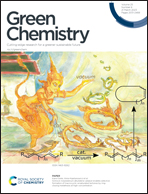Herbaceous plants-derived hydroxycinnamic units for constructing recyclable and controllable copolyesters†
Abstract
Lignin represents the most abundant renewable aromatic resource, monophenolics, from which would serve as promising monomers for the synthesis of aromatic polymers in a sustainable manner. Hererin, we report that hydroxycinnamic derivatives, i.e., ethyl coumarate/ferulate (pCA-Et and FA-Et), with a conjugate and rigid structure can be selectively fragmented from herbaceous plant lignin over a ZnMoO4/MCM-41 catalyst, which upon a one-pot fluorosulfonation, carboxylation, and esterification, give aromatic diesters in high yields. Copolymerizing lignin-derived dicarboxylic species with holocellulose-derived butanediol and adipic acid results in a new family of aliphatic–aromatic polyesters, which display controllable mechanical, optical, and thermal performance, especially depending on the methoxyl group in lignin-derived units. The as-prepared copolyesters can be fully converted into monomers via ethanolysis at 80 °C, demonstrating excellent chemical recyclability. Overall, we provide a novel upstream and downstream route to transform sustainable biomass into functional polymers.



 Please wait while we load your content...
Please wait while we load your content...